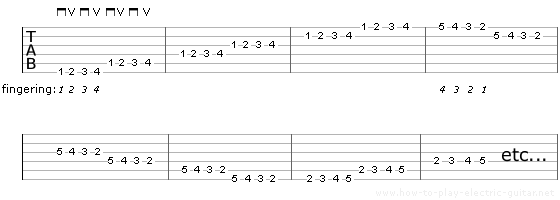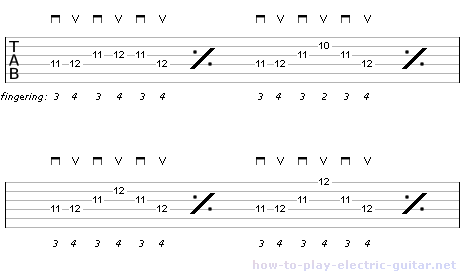Effective Guitar Exercises and Practice Tips
Why is it useful practicing guitar exercises?
- Warming up your fingers and hands before playing, significantly reduces the risk of damage to muscles and ligaments.
- The right exercises allow you to focus on and work out any of your weaknesses, making you a much better player with faster results.
The most powerful exercise to get fingers alive, in sync with the picking hand and with the beat (that's important) is this old school, chromatic passage:

Don't rush right away!
Many websites contain this drill, but not many say how to get the most out of it. I will in the following.
Begin with speed about 50 - 80 bpm when playing eighth notes with alternate picking, using a metronome or drum track for syncing.
Warm up, gain coordination and get comfortable, only then increase speed.
Important tips that will improve your playing
• The fingers should work like a system of little hammers, when one finger presses a string, the previous one slightly raises up. It really helps me to play notes with more accuracy.
• While working over the exercises watch and eliminate any unnecessary movements.
Keep the fingers close to the fingerboard (about 5-10 mm) so they could reach a string quickly even though you play slowly.
Your playing will be more solid due to the reduced time while you switch from one fret to another.
• The same principles of "closeness" can be applied to the picking hand when you're playing fast. The pick shouldn't move far away from the string it's picking. The less the distance, the faster and easier you'll be able to move.
• The distortion effect can hide your dynamic uncertainties by compressing the guitar sound (levelling high and low volume in some degree), so I'd recommend using a clean sound while exercising.
Another good chromatic drill is to play the main lick of Flight of the Bumble-bee theme.

After you've warmed up, it's time to talk about the main "secret" of fast progress and improvements. It lays in:
I'll show you how to do this in the following examples:
Example 1
I know that I have the most troubles with my pinky finger, it often hits strings slightly off time or presses them clumsily then jumps from one string to another. I have the same problem to a less degree with the ring finger.
After a little bit of experimenting I've developed the following exercise that not only does the job, but sounds pretty musical:

This guitar exercise has an abundance of movements between the ring and the pinky finger, plus it has a lot of jumps across the strings.
Example 2
Now that the pinky and ring finger are doing their job, I'd like to get on with string switches overall for all the fingers.
Once again, a little of experimenting and here it is, a good exercise that sounds musical, this time in a jazzy way.
Figure A
I use eighth note triplets to play these guitar exercises - three notes per beat.

Figure B

Feel free to play it wherever you want, starting from different strings, frets, directions.
Example 3
Another problematic area for many beginners is string skipping (jumping around distant from each other strings).
In order to make this exercise more fun, I took the notes of the minor pentatonic scale, also called a rock scale, because it's used in the vast majority of rock guitar solos. And jumped from string to string in this order: 1-3 2-4 3-5 4-6.
And I've come up with this exercise that sounds more like a guitar lick rather than a boring drill ;)


So if you want to create your own effective guitar exercise, just take a particular piece or riff or guitar solo you are having difficulty with.
Then practice the difficult piece on its own at a comfortable tempo (when you're able to make no mistakes), gradually increasing the speed until you reach normal speed.
I hope this article will help you to improve your playing. If you have any comments, questions or suggestions please post them here. I'm always interested in what you get to say.

I have one question: all the videos say "error" or "invalid source". The audio files play without any problem, but if you have a workaround for videos, that would be great. Once again, love the site, and thanks again.